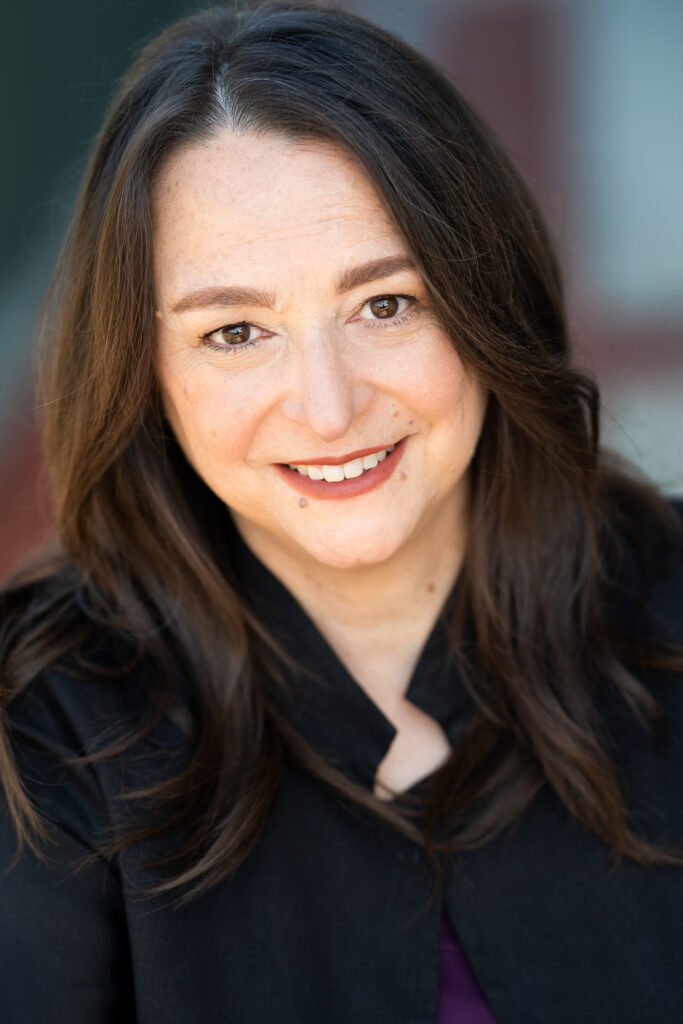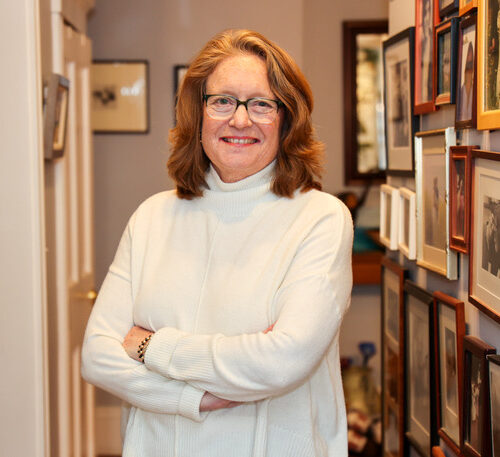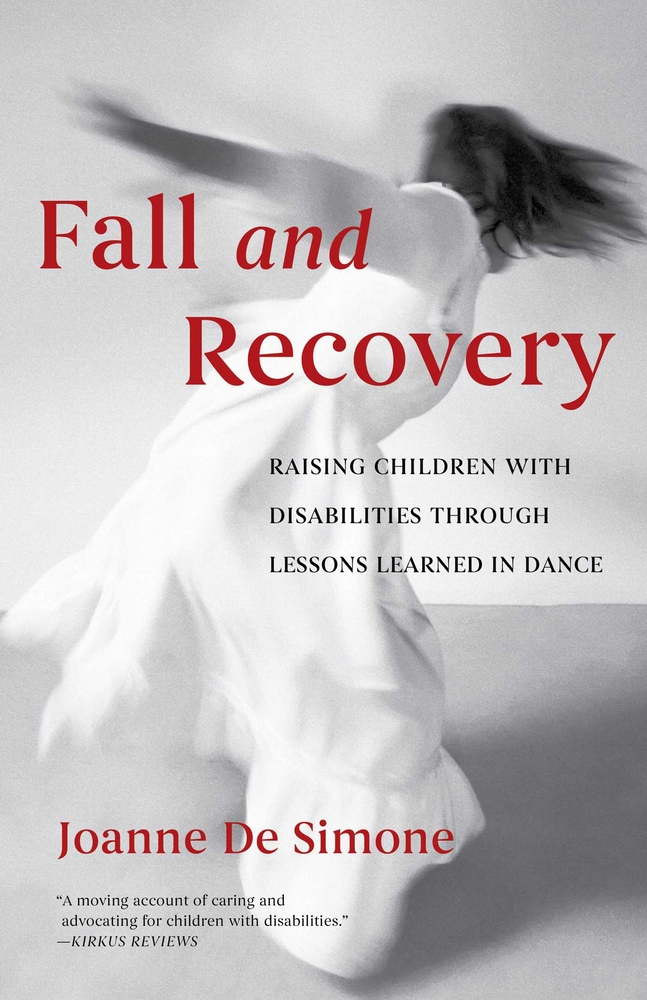Reviewed by Morgan Baker
I was so moved when I read Joanne De Simone’s memoir, Fall and Recovery: Raising Children with Disabilities through Lessons Learned in Dance. Not only was the writing and story gripping, the structure was so engaging.
De Simone was a gymnast most of her young life and became a dancer at 19. But between the death of her mentor and being shut out of a dance troupe, she had to pivot. She went back to school and got a special education degree. Then she had her own sons, one who was diagnosed with a life-limiting brain malformation, and several years later, her second son was diagnosed with Autism.
Inspired by her experience performing José Limón’s “There Is a Time,” based on Ecclesiastes 3, In Fall and Recovery, De Simone married her dance story with her mother story, using her performance experience to help her navigate her parenting. Each chapter has a phrase from Limón’s song and each chapter details a dance lesson and the dichotomy of parenting children with disabilities. This memoir resonates with all mothers as we all have experienced the loneliness, bewilderment, and love that comes with the job.
Morgan Baker: Hi. I loved your book. Congratulations on writing it, getting it published, and getting it out there so people will read it. It’s an important book. I just saw photos from your book launch — you, your husband, and Ben. You all looked so happy, and it was nice to put faces to names. How old are Ben and Sebastian now?
Joanne De Simone: Ben is 25 and Sebastian is 21.
MB: Wow. They grew up since I finished the book. When did you start writing Fall and Recovery?
JD: 2011. Ben must have been around 13. Sebastian must have been about 8 or 9. And I knew nothing about writing.
MB: What made you want to write this book?
JDS: A friend of mine who had worked on both of my son’s cases was teaching at a college for women who were studying to become special educators. She asked me to come in and talk to them about my parent experience. At the end they all came up and said, you have to write a book. Sure, in my spare time. I’d heard that before, but I thought educators need to hear the parent view and I should really write this story. It took 10 years. I worked on it on and off for about six years. I started to take workshops and sometimes I wrote essays…to get a platform, right?
But in all that time, I was trying to figure out what was missing in the book. I just didn’t have enough experience. I was missing structure. Something to really give it that universal feeling.
MB: How did you come up with using the song “To Every Season” as a way to structure it? Each chapter has another line from the song, which I’ve always loved, and danced to in middle school.
JDS: That song has always stayed in my head. There it was, and thought Oh my God what a really interesting way of structuring it because each of those lines meant something.
I had been thinking a lot about my experience dancing. It was like a lightning bolt. One day, I was like duh. There is a time to talk about the extremes of human experience. This is the dichotomy of what I’m experiencing as a parent.
When I wrote the first draft of the book, dance was not at all a focus. A teacher said, you know dance is the hook. Through the years, I wrote more and more about dance.
I took out all the dance parts and taped them out on index cards and laid them out on the floor. Then I wrote out the different parts of the psalm and connected them. I devised my own dichotomies and pieced them together with the dance lessons. That’s how the structure ended up coming about — I took the whole book apart and put it back together.
MB: Well, it worked. Your book showed both the nail polish and the dirt stuck under the nails. My challenges are different from yours, but as a mother with challenges, I felt seen. You also wrote about grief and love.
JDS: Even if you have the healthiest of children, they don’t always go in the direction you think they should. I have a lot of friends who have kids who don’t have disabilities and they’re afraid to talk to me. No. No. No. First of all, parenting is hard. You don’t have to have a child with a disability for it to be hard and for you to have a day where you feel I really don’t like my kid. People don’t want to hear that either, right? But show me a mother who hasn’t had a day like that, but we don’t say it.
Doesn’t matter that they have disabilities. That’s part of parenting. It’s difficult. There are both sides. There’s love and grief simultaneously. So how do you live with those things when, it can’t be resolved.
I realized I can link these experiences with what I thought were simple dance lessons. They were life lessons. In trying to get the book out there, I kept hearing the writing is love, but no one believed that motherhood and dance could work together. When my kids were really little, I went to the bookstore looking for parent memoirs. I would flip to the last page to see how it ended. If it was it’s all great and they’re fixed, I would put the book back on the shelf. I couldn’t relate to that story. Sometimes it doesn’t end well. And it’s just reality. So, let’s talk about how we’re living with it.

MB: You wrote about people “getting it”. I could relate. When I talk to parents of children with food allergies, they get it. I don’t have to explain how terrifying it is.
JDS: I always say there’s a lot you get as a parent, but I don’t know anybody else’s experience. I’m not going to assume that I do. There’s a connection when you know you’re part of a community. There’s nothing like the feeling when we moved into this home. We had been in West Orange for three and half years, and we moved again, I thought we’re going to have new neighbors now, and I’ll have to explain everything about the kids. When we met our next door neighbor, and immediately she said I have a son who’s autistic. I was like okay. We are good. You don’t have to say another word. No worries. I’m there. It’s an incredible feeling just to know you’re not going to be judged in the way you expect everyone to judge you.
It comes with the territory, especially when you have a child with a disability. All parents are judged, and it makes me crazy. In the world of disability, there is a lot of blame on the mothers. I stopped reading. I didn’t want to blame myself every second of the day.
MB: When I read about your journey, I thought, wow that’s a lot of heavy lifting. How did you manage to continue to do the heavy lifting and not fall apart? Caregiving is exhausting.
JDS: It has everything to do with community, right? Some of it is the family community. So, whatever my husband and I are dealing with in our relationship, at the end of the day, I still know that this a person who’s going to have my back.
There was the model of my mother, who was a very strong person. I watched her become a widow and have to pick herself up. When Ben started to go to school, I found other parents, just to speak to another parent and say, ‘I’m going to lose it. How am I going to do this? They’re there to lift you up?’
MB: I was also surprised and impressed that you had a job working in the world of Special Education. How did you do that?
JDS: I am a very structured person. I always have been. I’m very good at scheduling. So that was helpful. But at the end of the day, the truth was, I found great joy in being able to help with other families, giving them someone they could talk to and they knew I got it. It was therapeutic for me. It just made sense to me. It made me feel good to stay in it.
MB: The other thing I thought was interesting that you mentioned at the very beginning was the concept of wanting to bury your son before you die. That’s a hard thing.
JDS: I got upset the other day because I was thinking Oh my God, what if I died? What happens to them? It’s not about Benjamin and his worth as a human being. It’s about not being able to trust the world to do the right thing and take care of him. There is this fear. We die. He is going to be in a facility, and there won’t be enough staff. He will be ignored. Every night we put him to bed, we do a whole dance with his dolls and music. My husband said just last night, no one’s going to do this for him? Those are the things he enjoys that make him comfortable.
MB: I have two follow-up questions. One is about how Sebastian fits in? The other is how do you recharge?
JDS: No one tells you that parenting is just a series of letting go right from the minute they start toddling away. You let go of their hand, and that’s the start.
Sebastian is obviously in a completely different space than Ben. He’s got some intellectual disabilities. He’s such a good person, it’ll be easy for people to take advantage of him. He knows what he likes and what he wants, so he needs to have ownership in that, so we don’t have guardianship over him. We do have durable power of attorney.
It took me a little time, but when he’s got an assignment, it not for me to worry about. It’s his assignment. I’m here if he needs support, but he has to do it. This is his journey, not my journey. He’s emotionally smart which is not something you assume about the kid on the spectrum, but he definitely is. He feels things very deeply and he doesn’t always know how to put them into words. He’s bright. It’s just his processing is very slow.
MB: So where do you get recharged?
JDS: I don’t dance because I have an inner ear disorder called Meniere’s Disease. But I do a lot of walking and, writing always was the thing to recharge me. Even though writing the book was a lot of work, it was like therapy, and then going to a workshop where people are talking to you about it was like more therapy. It’s about validating yourself.
MB: Dancing was a huge part of your life. And then Jim died, and you were turned away from the LI…. I could feel the sadness and frustration and loss. There is so much about dance in the book, what were you able to take away – both the positive, negative. The sadness and how that influenced your life as a parent.
JDS: There’s a moment I talk about in the book — I was physically rewatching the video of THERE IS A TIME that we danced and at the end we’re all standing holding hands in a big circle. We’ve been through all the different extremes. I thought about my dad and the day he died, and sitting in church listening to my mother cry and my brother saying vows.
Honestly, during COVID I had sort of given up on putting this book out there. That was when I was diagnosed. With Meniere’s Disease. I had uncontrolled vertigo for seven months. There were days I was just in bed. Imagine the worst drunken state you’ve ever been in for six hours. The only thing really keeping me steady was thinking about the dance lessons. Just notice what it is. Don’t try to change anything. Just be present in your body and notice what’s happening. That’s when I got re-inspired to get the book out because it’s not just about parenting. It’s about life, and it’s about being able to use these lessons through your life and thinking they could be useful to other people.
MB: It’s a really good book. I can understand why people with children with disabilities would want to read it, because of the validation. But I also think people who don’t present with disabilities will appreciate it.
JDS: I think my goal is to help people in any stage of their life who have felt like a failure. This is how you can turn that around.

Morgan Baker
Staff InterviewerMorgan Baker writes about reinventing yourself, learning how to handle loss, and emerging from depression in her award-winning memoir Emptying the Nest: Getting Better at Good-byes (Ten16 Press). Other work can be found in the Boston Globe Magazine, The New York Times Magazine, The Martha’s Vineyard Times, Dorothy Parker’s Ashes, Grown & Flown, Motherwell and the Brevity Blog, among others. She teaches at Emerson College and is managing editor of The Bucket. She is the mother of two adult daughters and lives with her husband and two Portuguese water dogs in Cambridge, Mass. She is an avid quilter and baker.



